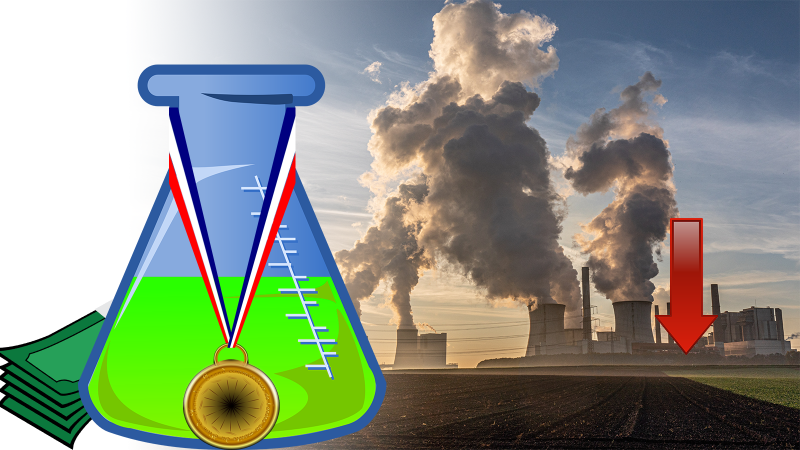
A student-led team named SASIITB from the Indian Institute of Technology Bombay is one of the 23 winning teams of the XPRIZE Carbon Removal Student Competition. The team has proposed a carbon dioxide capture system that can remove carbon dioxide from gaseous industrial effluents and convert it into commercially and industrially valuable chemicals. “Winning this competition is a dream come true for us since we always dreamt of representing India in an international forum,” said the delighted student members Srinath Iyer, Anwesha Banerjee, Srushti Bhamre and Shubham Kumar. They were mentored by Prof Arnab Dutta and Prof Vikram Vishal.
Each winning team will get prize money of about ₹186 lakh (US$250,000). Expert third-party judges chose the winning teams based on the innovativeness of the proposal, its feasibility, potential impact and ability to remove gigatons of carbon dioxide. They also considered the resources and capabilities of the team members. SASIITB won under the category, Carbon Dioxide Removal Demonstration.
There is an urgent need to address the climate emergency due to the earth’s rising temperatures. Emissions from human activities such as burning fossil fuels for energy, industrial processes, vehicles, and extreme agricultural practices have become large enough to upset the earth’s natural balanced carbon cycle. Carbon dioxide is one of the leading contributors to the rise in temperature, in addition to other greenhouse gases such as methane and nitrous oxide.
Over the past few decades, we have far exceeded the safe limit of carbon dioxide emissions. It is not enough for us to stop carbon dioxide from entering the atmosphere, but we also need to find ways to absorb it in sufficiently large quantities from air, land and oceans. The need is urgent as well as long term. Hence an appropriate solution to remove carbon dioxide should be immediately feasible, effective at a large scale and sustainable for a long time.
The SASIITB team proposed a two-pronged approach to the carbon dioxide removal process. Carbon dioxide is captured from gaseous industrial waste in the first stage. It is converted to useful industrial chemicals in the second stage, thus eliminating carbon dioxide permanently.
Substances such as ammonia and monoethanolamine (MEA), called amine-based organic bases, are currently used to capture carbon dioxide from industrial flue gases. However, these chemicals are corrosive and hence hazardous. “We suggest using less hazardous amine-containing aqueous solutions that can remove carbon dioxide by adsorption (making carbon dioxide molecules stick to the surface of the solution) in the presence of an appropriate additive,” explains Prof Dutta. The team is currently developing the correct combination of the ingredients in an aqueous medium to ensure efficient carbon dioxide adsorption at various temperature and pressure ranges.
Once the capture unit segregates the carbon dioxide, it is converted to useful chemicals in a separate unit. Here, the capture and convert units can be assembled as per the practical requirements. The team is exploring chemical reactions to convert the captured carbon dioxide to solid carbonate salts, which will spontaneously precipitate from the reaction mixture. The rest of the solution can be reused in the carbon capture unit. It may be possible to choose a chemical reaction to produce a specific carbonate salt selected based on its commercial viability and potential applications.
“Our proposal stands out because this process provides the options of both CO2 capture and sequestration to the industries along with the possibility of long-term sequestration,” says Anwesha Banerjee. “Also, our methods are energy-efficient and cost-effective,” chips in Srushti Bhamare.
Modifying an already existing process to add a carbon capture unit requires investment. Carbonate salts are useful in agriculture, biochemical, pharmaceutical and other industrial applications. Industries that need to retrofit the carbon capture schemes are more likely to accept a solution that yields useful chemicals, as it can help offset the expenditure.
“India could be the key player to develop sustainable, scalable and cost-effective technology in the world, for carbon capture, utilisation and storage,” comments Shubham Kumar. “I feel very proud being a member of the Indian winning team. Ours is the only single institution team from a developing country in the list of winners,” says Srinath Iyer.
The student award competition is a part of a larger initiative, the $100M XPRIZE Carbon Removal supported by the Musk Foundation. The student competition winners are eligible to participate in the XPRIZE Carbon Removal Milestone and Grand Prize Competition. As a target for this competition, the participating teams will have to demonstrate a solution capable of removing 1000 tonnes of carbon dioxide from the atmosphere or oceans. They will need to give a cost estimate model for removing one million tonnes of carbon dioxide a year and show how the method can be scaled for removing one gigaton of carbon dioxide.
“Reducing emissions may not be enough for the world to reach net-zero. Methods (such as ours) for active removal of CO2 need to be developed and up-scaled,” says Prof. Vikram Vishal.
The team feels confident about making this idea successful. “Going ahead, our prime focus will be to lower the energy requirements and optimise the cost of the complete carbon capture, utilisation and storage system,” conclude the team.
This article has been run past the researchers, whose work is covered, to ensure accuracy.

























